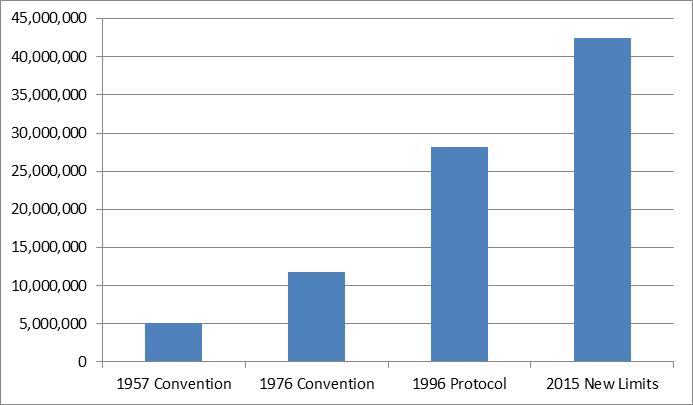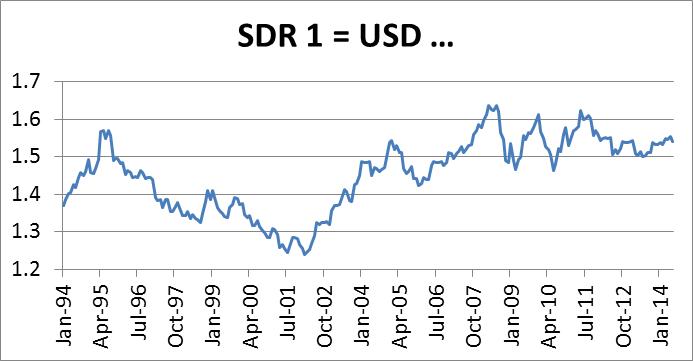The 1996 Protocol to the Convention on Limitation of Liability for Maritime Claims (LLMC) that was adopted in April 2012 and which take effect in June 2015 substantially increases the limits of liaiblity.

Increased limits of liability enter into force in 2015
Published 07 July 2014
Prompted by the amendments to increase the limits of liability in the 1996 Protocol to the Convention on Limitation of Liability for Maritime Claims (LLMC) that were adopted in April 2012 and which take effect in June 2015, this article takes a retrospective look at the developments in limitation regimes mainly since the entry into force of the LLMC 1976; summarises the changes and discusses the reasons for them.
Background Historically, limitation of liability was originally based upon the concept of ’abandonment’ which also formed the basis for the International Convention for the Unification of Certain Rules Relating to the Limitation of the Liability of Owners of Sea-going Vessels 1924. Thus the ’limitation’ amount was essentially based on the value of the ship post-casualty. It was the International Convention relating to the Limitation of the Liability of Owners of Seagoing Ships 1957 that first introduced tonnage related limits that were then followed by the LLMC Convention 1976. 1
Specific tonnage-based figures were set by the LLMC, providing the maximum financial liability of the “shipowners2 and salvors” in respect of all claims arising out of maritime incidents involving primarily personal claims (injury and loss of life) as well as property damage claims (such as damage to the other ships, property or harbour works). The unit of measurement for monetary liability used is the Special Drawing Right (SDR) which is an interest-bearing international reserve asset created by the IMF in 1969. It should be noted that the SDR is not a currency but is based on a basket of international currencies comprising the US dollar, Japanese yen, euro and pound sterling.
Limitation provisions can also be found in other international conventions such as the International Convention on Civil Liability for Oil Pollution Damage, the package limitations provided by the Hague and Hague-Visby Rules in relation to cargo claims and by the Athens Convention 1974 in relation to claims by individual passengers.
LLMC 1976 By virtue of Article 3(1) of the 1957 Convention, the limitation fund for property claims is set at 1,000 Gold Francs per tonne (SDR 66.67 per tonne under the 1979 amending Protocol) whereas for personal claims the fund is set at 3,100 Gold Francs per tonne (SDR 206.67 per tonne under the 1979 amending Protocol). The LLMC 1976 significantly increased the above levels of limitation, in some cases up to 250-300 per cent. It also provided for a practically unbreakable system of limiting liability by imposing on the party challenging the right to limit the burden of proving that the loss resulted from the shipowner’s “personal act or omission, committed with the intent to cause such loss, or recklessly and with knowledge that such loss would probably result”.3 The recent decision of the Supreme Court of Canada in the Peracomo case serves as clear evidence of the fact that the system of limiting liability introduced by the LLMC 1976 is virtually unbreakable.
A separate set of limits were adopted for personal injury claims on which higher limits apply as opposed to property claims. The limits were set at SDR 333,000 for personal claims for ships up to 500 tonnes plus the following additional amounts based on tonnage:
- For each tonne from 501 to 3,000 tonnes, SDR 500.
- For each tonne from 3,001 to 30,000 tonnes, SDR 333.
- For each tonne from 30,001 to 70,000 tonnes, SDR 250.
- For each tonne in excess of 70,000 tonnes, SDR 167.
For other claims, the limit was fixed at SDR 167,000 plus the following additional amounts based on tonnage on ships above 500 tonnes:
- For each tonne from 501 to 30,000 tonnes, SDR 167.
- For each tonne from 30,001 to 70,000 tonnes, SDR 125.
- For each tonne in excess of 70,000 tonnes, SDR 83.
The 1996 Protocol The 1976 limits were eventually eroded by inflation and by a reduction in the average purchasing power of the SDR and as a result new limits were adopted under the 1996 Protocol which were approximately 250 per cent higher than those under the 1976 Convention.
The limit of liability for personal injury claims up to 2,000 gross tonnes was set at SDR 2 million. For larger ships, the following additional amounts were used in calculating the limitation amount:
- For each tonne from 2,001 to 30,000 tonnes, SDR 800.
- For each tonne from 30,001 to 70,000 tonnes, SDR 600.
- For each tonne in excess of 70,000 tonnes, SDR 400.
The limit of liability for property claims for ships not exceeding 2,000 gross tonnes was SDR 1 million. For larger ships, the following additional amounts were used in calculating the limitation amount:
- For each tonne from 2,001 to 30,000 tonnes, SDR 400.
- For each tonne from 30,001 to 70,000 tonnes, SDR 300.
- For each tonne in excess of 70,000 tonnes, SDR 200.
Importantly, Article 8 of the Protocol also provides for the limits to be updated in future by means of the ’tacit acceptance’ procedure which means that any amendment adopted shall be deemed to have been accepted at the end of a period of eighteen months after the date of notification to all contracting states4 and shall enter into force eighteen months after its acceptance, i.e. a total of 36 months.
The new limits On 19 April 2012, the IMO announced new limits to enter into force, in accordance with the tacit acceptance procedure, on 8 June 2015.
The new limit of liability for claims for loss of life or personal injury on ships not exceeding 2,000 gross tonnes will be increased to SDR 3.02 million whereas for larger ships the following additional amounts will be used in calculating the limitation amount:
- For each tonne from 2,001 to 30,000 tonnes, SDR 1,208 (up from SDR 800).
- For each tonne from 30,001 to 70,000 tonnes, SDR 906 (up from SDR 600).
- For each tonne in excess of 70,000 tonnes, SDR 604 (up from SDR 400).
The limit of liability for property claims for ships not exceeding 2,000 gross tonnes will be SDR 1.51 million whereas for larger ships the additional amounts to be used in calculating the limitation amount are as follows:
- For each tonne from 2,001 to 30,000 tonnes, SDR 604 (up from SDR 400).
- For each tonne from 30,001 to 70,000 tonnes, SDR 453 (up from SDR 300).
- For each tonne in excess of 70,000 tonnes, SDR 302 (up from SDR 200).
The above figures constitute a relatively modest increase of 51 per cent.
Practical Example To illustrate more clearly the significance of the above increases, let’s take the hypothetical example of a bulker called the OCEAN LIMIT with a GT of 50,000 and examine how the limitation amount for property damage would differ under the 1957 and 1976 Conventions, as well as the 1996 Protocol and the latest amendments to its limits:
OCEAN LIMIT limitation fund for property claims under:
1957 Convention would amount to SDR 3,333,500 (approx. USD 5,155,000).
1976 Convention would amount to SDR 7,593,500 (approx. USD 11,743,000)
1996 Protocol would amount to SDR 18,200,000 (approx. USD 28,144,000)
2015 New Limits would amount to SDR 27,482,000 (approx. USD 42,500,000)
The development of limitation amounts over time

LimitationFund_Comparison
Factors inducing LLMC amendments Article 8.5 of the 1996 Protocol provides for three factors to be taken into consideration when acting on a proposal to amend the limitation amount, namely: (i) the experience of incidents; (ii) the changes in monetary values, and (iii) the effect of the proposed amendment on insurance costs.
Arguably the main factor prompting the latest amendments is the change in monetary values during the period since the limits were previously set and the above increase reflects this change. This is illustrated in the proposal to amend the 1996 limits that was submitted by Japan to the Legal Committee of the IMO, which was also fully supported by the International Chamber Shipping (ICS) and the International Group of P&I Clubs (IG) in their joint proposal. The above proposal concludes that the changes in the inflation rates between 1996 and 2010 do not exceed 45 per cent and therefore the amendments in the limitation amounts should reflect the above changes. Other contracting states, such as Australia, supported a significantly higher increase of 147 per cent. Eventually it was the more modest approach that was accepted, which based the increase on the above mentioned changes in inflation rates and also took into consideration the additional period (36 months) before entry into force.
As to the experience of incidents, the prevailing view was that the very small number of claims (mostly bunker pollution incidents) that have exceeded the 1996 Protocol limits suggests that limitation is operating effectively. After all, as noted at the 98th session of the Legal Committee meeting, “a limit which is too high could effectively void the concept of limitation of liability”.5
Conclusion Overall the above increases are to be welcomed as they bring the limitation figures in line with recent changes in monetary values. They ensure that any increases of insurance costs should be at a reasonable level and set the basis for modest future increases and do not make the Convention unattractive to those states that are considering ratifying it.
Shipowners as well as charterers, managers and operators of vessels and their respective insurers should be aware of the above pending increases and should review their contractual and insurance arrangements to ensure their adequacy in the context of the new increased limits.
Development in the value of the SDR against the US Dollar

SDR_USD_values
Questions or comments concerning this Gard Insight article can be e-mailed to the Gard Editorial Team.
1 As amended in 1996 and 2012.2 “Shipowner” includes the “owner, charterer, manager or operator of a seagoing ship” and the right to limit is extended to “any person for whose act, neglect or default the shipowner or salvor is responsible” (see Article 1).3 Article 4 of the LLMC 1976.4 Unless within that period not less than one-fourth of the states that were contracting states at the time of the adoption do not accept the amendment.5 See document LEG 98/14, par. 7.7.


